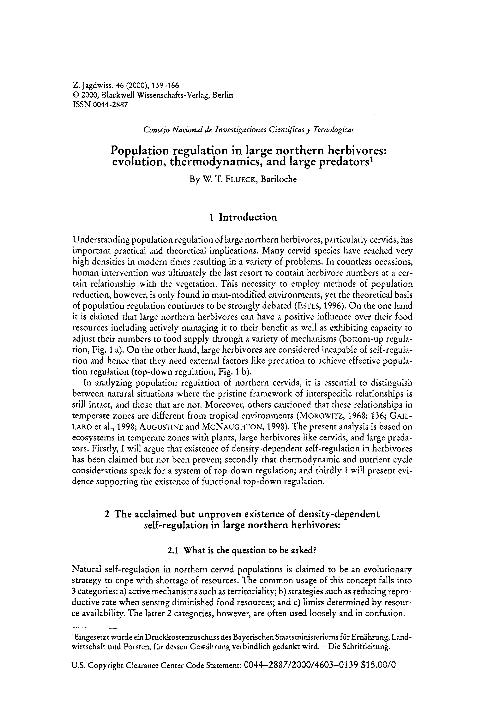Mostrar el registro sencillo del ítem
dc.contributor.author
Fluck, Werner Thomas

dc.date.available
2018-03-27T14:00:42Z
dc.date.issued
2000-12
dc.identifier.citation
Fluck, Werner Thomas; Population regulation in large northern herbivores: Evolution, thermodynamics, and large predators; Blackwell Verlag GmbH Berlin; Zeitschrift fur Jagdwissenschaft; 46; 3; 12-2000; 139-166
dc.identifier.issn
0044-2887
dc.identifier.uri
http://hdl.handle.net/11336/40115
dc.description.abstract
Understanding population regulation of large northern herbivores like cervids has important practical and theoretical implications. Corrective measures for high densities of cervids must be based on theory and thus necessitate analysis of contradicting views of top-down and bottom-up population control. The former considers cervids incapable of self-regulation and hence that they need external factors like predation to achieve effective population regulation. The latter claims that cervids exhibit the capacity to adjust their numbers to the food supply as shown by physiological responses. However, these phenomena are not an expression of evolutionary adaption, they are a predictable physiological reaction to reduced food. In addition, studies were often done in man-modified environments or without considerations of modulating effects through predators. It is unlikely to study pristine relationships between large herbivores and predators in the future through field work, and insights from other fields need to be heeded. Considerations from evolution, thermodynamics, food webs and nutrient cycling indicate that the development of biological systems is unidirectional due to irreversible processes and leads toward optimal order and optimal accumulation of energy and nutrients. Large predators are thus not just a luxury development of evolution, but a necessary sequel to natural laws and they increase efficiency of the system to capture solar energy. It explains why analogous ecomorphs, like saber-tooth 'cats' (placental and marsupial) have re-evolved independently at least 5 times. As a group, large predators developed traits allowing self-regulation including territoriality, intra- and interspecific killing, prey-switching, and dispersal. However, in man-modified environments, herbivore densities can reach such high levels that even an intact predator community will no longer exert regulation as there is an upper limit of predator density determined by social mechanisms. As kill success rates are very low, predators also affect herbivores by largely determining spacial distribution and behavioral adaptions, all of which modify herbivore-plant interactions. Cervids on the other hand exhibit traits all indicative of absence of a capacity to self-regulate. Predictable physiological responses to reduced food intake thus operate so late that the typical population response is an irruption with subsequent major dieoff and leads to a reduction in system performance including loss of biodiversity. Therefore, the claim that there exists 'natural' regulation in such situations is an erroneous term for what is better called forced starvation. Two conclusions can be drawn: 1. Herbivore densities above a critical level will inevitably cause shifts in community functioning by altering plant and animal species composition, nutrient and energy flow patterns: the system will effectively be forced to a less complex and hence, less productive level, an evolutionary step backwards. 2. By having modified ecological parameters necessary for the welfare of herbivores, we need to take on the responsibility to guarantee their future welfare by actively replacing missing factors. For cervids it may mean implementing harvesting such that population densities permit natural plant rejuvenation and optimal biodiversity. Where the predator community is still intact, it should be protected by all means, and where still possible, predator communities should be restored. A basic tool is to disseminate the best available information, namely that large northern herbivores do not exhibit self regulation.
dc.format
application/pdf
dc.language.iso
eng
dc.publisher
Blackwell Verlag GmbH Berlin
dc.rights
info:eu-repo/semantics/openAccess
dc.rights.uri
https://creativecommons.org/licenses/by-nc-sa/2.5/ar/
dc.subject
Large Predator
dc.subject
Herbivore Density
dc.subject
Predator Community
dc.subject
Behavioral Adaption
dc.subject
Interspecific Killing
dc.subject.classification
Otras Ciencias Biológicas

dc.subject.classification
Ciencias Biológicas

dc.subject.classification
CIENCIAS NATURALES Y EXACTAS

dc.title
Population regulation in large northern herbivores: Evolution, thermodynamics, and large predators
dc.type
info:eu-repo/semantics/article
dc.type
info:ar-repo/semantics/artículo
dc.type
info:eu-repo/semantics/publishedVersion
dc.date.updated
2018-03-16T14:30:09Z
dc.journal.volume
46
dc.journal.number
3
dc.journal.pagination
139-166
dc.journal.pais
Alemania

dc.journal.ciudad
Berlin
dc.description.fil
Fil: Fluck, Werner Thomas. Consejo Nacional de Investigaciones Científicas y Técnicas; Argentina
dc.journal.title
Zeitschrift fur Jagdwissenschaft
dc.relation.alternativeid
info:eu-repo/semantics/altIdentifier/doi/http://dx.doi.org/10.1007/BF02241353
dc.relation.alternativeid
info:eu-repo/semantics/altIdentifier/url/https://link.springer.com/article/10.1007%2FBF02241353
Archivos asociados
